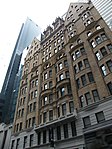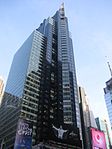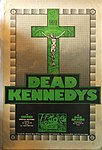Millennium Times Square New York

The Millennium Times Square New York (formerly the Hotel Macklowe and the Millennium Broadway) is a hotel at 133 and 145 West 44th Street, between Times Square and Sixth Avenue, in the Theater District of Midtown Manhattan in New York City. Operated by Millennium & Copthorne Hotels, the hotel has 750 guest units, as well as a conference center with 33 conference rooms. The hotel incorporates a Broadway theater called the Hudson Theatre into its base. The hotel is composed of two guestroom towers, which flank the Hudson Theatre. The original 48-story tower west of the theater was designed by William Derman and Perkins & Will, while the 22-story annex east of the theater was designed by Stonehill & Taylor. The original hotel tower contains a lobby with a passageway connecting two entrances on 44th and 45th Streets. In addition, there is a bar, restaurant, and fitness center in the original tower. The conference center in the lower stories extended into the Hudson Theatre, which in 2017 became a Broadway theater. The 22-story annex is branded as the Millennium Premier New York Times Square. The hotel's original tower was developed by Harry Macklowe as the Hotel Macklowe. Though Macklowe had acquired land for the hotel in the early 1980s, he was penalized after illegally demolishing four structures on the site in 1985, and he could not develop the site until 1987. The original tower opened in early 1990 and incorporated the Hudson Theatre into the conference center. Chemical Bank acquired the hotel from Macklowe through foreclosure in 1994, reselling to CDL Hotels, which renamed it the Millennium Broadway. From 2019 to 2021, the Millennium Times Square New York was affiliated with the DoubleTree brand of Hilton Hotels & Resorts. Afterward, Highgate was hired to manage the hotel instead.
Excerpt from the Wikipedia article Millennium Times Square New York (License: CC BY-SA 3.0, Authors, Images).Millennium Times Square New York
West 45th Street, New York Manhattan
Geographical coordinates (GPS) Address Nearby Places Show on map
Geographical coordinates (GPS)
| Latitude | Longitude |
|---|---|
| N 40.757222222222 ° | E -73.984722222222 ° |
Address
West 45th Street 150
10036 New York, Manhattan
New York, United States
Open on Google Maps









